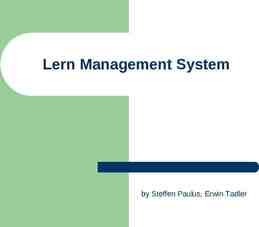Expanding Pharmacists’ Participation in Value-Based
40 Slides9.46 MB
Expanding Pharmacists’ Participation in Value-Based Arrangements (VBAs): A Look at NCPDP Standards & its VBA Roadmap Pharmacy Informatics Town Hall September 27, 2022 In collaboration with NCPDP 1
HIMSS Overview HIMSS is a global advisor and thought leader supporting the transformation of the health ecosystem through information and technology. As a mission-driven non-profit, HIMSS offers a unique depth and breadth of expertise in health innovation, public policy, workforce development, research and analytics to advise global leaders, stakeholders and influencers on best practices in health information and technology. With more than 350 employees, HIMSS has operations in: North America Asia Pacific Europe Latin America Middle East United Kingdom 2
About NCPDP Founded in 1977, NCPDP is a not-for-profit, ANSI-accredited, Standards Development Organization with over 1,500 members representing virtually every sector of the pharmacy services industry. NCPDP members have created standards such as the Telecommunication Standard and Batch Standard, the SCRIPT Standard for e-Prescribing, the Manufacturers Rebate Standard and more to improve communication within the pharmacy industry. Our data products include dataQ , a robust database of information on more than 80,000 pharmacies, HCIdea , a database of continually updated information on more than 2.5 million prescribers, and resQ , an industry pharmacy credentialing resource. NCPDP's RxReconn is a legislative tracking product for real-time monitoring of pharmacy-related state and national legislative and regulatory activity. www.ncpdp.org In collaboration with NCPDP 3
Lee Ann Stember President & CEO, NCPDP Lee Ann Stember is President & CEO of NCPDP, a not-for-profit multi-stakeholder forum for developing healthcare business solutions, including ANSI-accredited standards for electronic exchange of healthcare information. As President & CEO for four decades, she has led NCPDP to continued success in its transformative role in pharmacy services, creating and promoting adoption of consensus-based standards and best practices that improve patient safety and decrease costs. Stember represents NCPDP and the work of its membership to government agencies, other standards development organizations, healthcare industry associations and coalitions seeking to achieve HIT interoperability and other reforms that improve the coordination and quality of care while reducing system costs. 4
Kim Boyd Industry Consultant, Member of NCPDP Board of Trustees Kim Boyd is an Industry Consultant with over 25 years’ experience in health care. She specializes in strategic planning, health care policy, market intelligence, interoperability, Health Information Technology (HIT) and health care standards. Kim’s early health care experience was in the worker’s compensation market but over the last 15 years her focus has spanned Medicare, Medicaid, and commercial markets. Kim has developed and executed on Federal and state health care policy, legislative and regulatory advocacy, stakeholder and industry engagement, and standards engagement across several health care priorities, including but not limited to electronic prior authorization, realtime prescription benefit, patient access and affordability, data and cost transparency and exchange. Kim is a 21-year member of the NCPDP, a NCPDP Board of Trustee, Co-Chair of NCPDP’s Strategic Planning Committee, Chair of the Value Based Agreement Subcommittee, and former task group lead for the Prior Authorization Transactions task group. Kim is also active in the Health Level 7 (HL7) Accelerator CodeX, leading the Prior Authorization in Oncology use case. 5
Disclosures Lee Ann Stember has no relevant financial relationships with ineligible companies to disclose. Kim Boyd is a past employee of McKesson. All relevant financial relationships have been mitigated. 6
Lee Ann Stember In collaboration with NCPDP 7
Learning Objectives At the end of this presentation, pharmacists and pharmacy technicians will be able to: 1. Describe why standards support for pharmacist participation in Value-Based Arrangements (VBAs) is a National Council of Prescription Drug Program (NCPDP) strategic priority. 2. Name the NCPDP standards that can support pharmacists’ participation in VBAs today. 3. Describe a use case for the role of a pharmacist in a VBA. 4. Name two quality measures that support quality improvement in VBAs. In collaboration with NCPDP 8
Providing standards support for pharmacist participation in Value-Based Arrangements (VBA) is an NCPDP priority The Time Is Now. Industry focus on value Gaps in care in rural and underserved populations Aging U.S. population, chronic conditions Pandemic In collaboration with NCPDP 9
An NCPDP Strategic Priority is to ensure the goal of VBAs to enhance outcomes and lower total cost of care In collaboration with NCPDP 10
Pharmacists can help optimize the success of VBAs Close gaps in care – provide comprehensive, collaborative care including Medication Therapy Management (MTM). Medication therapy optimization can help reduce total cost of care. Clinical pharmacists are the medication experts. Pharmacists are well positioned to perform a variety of patient care functions. Administer Immunizations; Testing; Manage medication therapies; Monitor patient therapies when transitioning from hospital to home; Measure/monitor blood pressure, blood sugar; Participate in outcomes reporting; and more! 1 In collaboration with NCPDP With nearly 9 in 10 Americans living within 5 miles of a community pharmacy, your pharmacist may be the health professional you see most often and talk with about your health.1 https://www.cdc.gov/heartdisease/pharmacist.htm 11
Pharmacists can help optimize the success of VBAs Pharmacists-provided services can effectively augment physician care and assist in closing gaps in care. Population health management; Medication therapies; Care plan coordination; Social Determinants of Health (SDoH) Pharmacists were on the front lines of the pandemic, providing clinical services – COVID-19 testing and immunization. Patients visit their community pharmacist 12 times more frequently that they visit their primary care provider.2 2 In collaboration with NCPDP https://www.fdsrx.com/expanding-role-community-pharmacists/ 12
The shift to a more comprehensive, patientcentered model of care for pharmacists is Clinical occurring pharmacists are Collaborative practice agreements (CPAs) with physicians Consulting contracts with physician groups Readiness to participate in VBAs exists within the community pharmacy community. Clinical pharmacists recommend medications to give to patients and oversee the dosage and timing of the delivery of those medications. They also may conduct some medical tests and offer advice to patients. 3 3 In collaboration with NCPDP involved in direct patient care; they spend little time dispensing prescriptions.3 https://www.bls.gov/ooh/healthcare/pharmacists.htm#tab-2 13
Standards are necessary to support interoperable, bi-directional, real-time exchange of information Standards are needed. Using existing NCPDP Standards, pharmacists already collect – or can collect and document - much of the data that would be valuable in a VBA with pharmacist participation. There are hurdles to overcome to enable sharing that data and integrating pharmacists into VBAs. In collaboration with NCPDP 14
NCPDP has a role in supporting in VBAs As a problem-solving forum and ANSI-accredited SDO, NCPDP is a natural fit for looking at how standards can better support value-based models of care that are inclusive of pharmacists. Existing NCPDP standards, modifications In collaboration with NCPDP Migrate information into other standards New standards created by NCPDP or in collaboration with other SDOs Collaboration with other SDOs interoperabilit y between medical and pharmacy 15
NCPDP has a role in supporting in VBAs Research and discovery have been key to advancing our goal to provide standards support for Value-Based Arrangements. Learn as much as possible about use of VBAs in industry, pharmacy participation, requirements, quality measures and information gaps. In collaboration with NCPDP 16
NCPDP’s VBA Framework In collaboration with NCPDP 17
NCPDP Standards already have data elements to support pharmacists’ participation in VBAs Analysis of existing standards for existing transactions that can support VBA : NCPDP Telecommunication Standard NCPDP SCRIPT Standard NCPDP/HL7 eCare Plan In collaboration with NCPDP 18
NCPDP Standards already have data elements to support pharmacists’ participation in VBAs 80 70 67% 62% 60 42% 50 40 30 20 10 0 Summary Key Learnings SCRIPT V2017071 In collaboration with NCPDP Telecom Version D.0 eCare Plan 19
Kim Boyd In collaboration with NCPDP 20
The NCPDP Standards Road to Value One and half years into the Three-Year Strategic Plan Strategic Planning VBA Subcommittee has been focused on fact finding and execution Determine how NCPDP current or future standards can support and promote the growth of pharmacist as a part of the care team in relation to value-based arrangements Collaborated with NCPDP staff, NCPDP membership, the pharmacy and medical services industry Evaluate where we are today in being able to truly support this growth and not only with a focus on NCPDP standards but also on evaluating and measuring pharmacist inclusion in VBAs and industry readiness to do so In collaboration with NCPDP 21
COVID COVID shocked the healthcare system, while physician clinic and hospital visits shrank, pharmacy grew Pharmacies have increasingly become immersed in service-related care for patients Pharmacist clearly stepped into a clinical, collaborative role during and beyond the COVID-19 pandemic, administering vaccines as well as other clinical services State regulations are evolving to support Pharmacist practicing at the top of their license and billing for patient-focused, consultative services, not just dispensing https://www.healthaffairs.org/do/10.1377/forefront.20201214.543463/ full/ In collaboration with NCPDP 22
Closing Gaps In Care via VBA is a Community Approach NCPDP held a series of Stakeholder Action Groups and an Educational Summit to ascertain the healthcare community's opinions and expertise The VBA Subcommittee also conducted 1:1 interviews In collaboration with NCPDP Industry Subject Matter Experts From Across the Healthcare Ecosystem Have Informed Findings and Needs to Support Pharmacist Engaged VBAs: Pharmacies National Quality Organization HIT Solutions Vendors VBA Platform Vendors Manufacturers Health Plans Advocacy Organizations Pharmacist Associations Software Vendors Private Research University 23
NCPDP Data Standards Evaluation – Support for Pharmacist Involved VBA Today In early 2022, NCPDP Standards SMEs completed initial analysis and data crosswalk of NCPDP standards that could be used to support VBA and the exchange of clinical data 62% of data elements in SCRIPT Standard 42% within TELECOM 67% within eCare Plan Examples of NCPDP Standards Clinical Data Fields: Hemoglobin A1C Diastolic/Systolic Blood Pressure Immunizations Heart Rate Respiratory Rate Laboratory (Labs) Date of Test Date Test Results Received In collaboration with NCPDP 24
NCPDP July 2022 Stakeholder Action Group (SAG) Cross Section of Healthcare, Pharmacy Industry Open, consensus dialogue Patient at the center of the discussions Pharmacist involved VBAs (not competitive but complimentary of Primary Care Provider VBAs) Areas of discussion Comprehensive care planning Pharmacy systems improvement and integration with medical EHRs Promote health and wellness Need for tracking and billing system (not all activity tied to dispensing medications) Encompass transitional care Complete care coordination to close gaps in care In collaboration with NCPDP 25
Key Takeaways - NCPDP July SAG YES – NCPDP Should Pursue these efforts Pharmacist provider status variability could be a challenge In collaboration with NCPDP How are pharmacy management systems or vendors supporting VBAs today – is it on their roadmap? Interoperabilit y should be front and center – converge pharmacy and medical info sharing in realtime Credentialing for Pharmacist is not consistent and should be addressed Pharmacist can help minimize costs and close gaps in care as part of VBAs 26
Potential Pharmacist VBA Use Case Objectives: Evaluate the ability of current NCPDP standard(s) to execute on sending certain patient, medication and encounter data to value-based arrangement (VBA) partners (i.e., primary care provider, payer/plan or their technical partner (intermediary, EHR, etc.). Understand the ability of NCPDP standard(s) to deliver, in real time, the VBA data to be consumed and acted upon by VBA partners but not associated with a claim, i.e., send the data only. Design: Driven by payer VBA criteria, evaluate each data-element presently available in NCPDP standard(s), including but not limited to Telecommunication, SCRIPT, eCare Plan and any other relevant NCPDP standard that would capture clinical data elements based on given parameters for four pharmacy-payer VBA measurement areas: A1c Control and Improvement Data needed to support the reporting and measurement of A1c Improvement and Control A1c Value Range – free text value or Code (CPT/HCPCS/SNOMED/LOINC) A1C Value Date NDC or RxNORM for medication received by the patient Date received ICD, CPT, HCPCS In collaboration with NCPDP Despite the importance of medication adherence, nonadherence to OAMs represents a substantial problem in the United States, with medication adherence rates ranging from 36% to 59% among elderly patients with diabetes. (CMS) Chronic Conditions Data Warehouse indicates that 27.5% of Medicare fee-forservice (FFS) beneficiaries had a diagnosis of diabetes in 2019 Insulin is a lifesaving medication for all people with type 1 diabetes and many with type 2 diabetes. One in every three Medicare beneficiaries has diabetes, and more than 3.3 million Medicare beneficiaries use one or more of the common forms of insulin. https://www.cms.gov/About-CMS/Agency-Information/OMH/Downloads/Data-Snapshots-Diabetes.pdf https://www.jmcp.org/doi/pdf/10.18553/jmcp.2020.26.9.1099?download true https://diabetesjournals.org/care/article-abstract/45/8/1814/147083/Projected-Impact-of-the-Medicare-Part-D-Senior?redirectedFrom fulltext 27
NCPDP Next Steps Post-SAG Outreach and survey to pharmacy management systems and vendor organizations regarding the interoperability roadmaps to support pharmacist access, use and exchange of clinical data and billing for clinical services Continue working with NCPDP member – adding to current standards and promoting adoption or determine if a wholly new standard is needed Promote Use Case Execution – Possibly through NCPDP Foundation NCPDP Leadership to communicate and collaborate with industry stakeholders on the issue of Pharmacist Credentialing and recognition of credentialing in VBAs Continue working with measurement development organizations to create meaningful pharmacist specific measures for quality care and closing gaps in care In collaboration with NCPDP 28
Measuring Success NCPDP continues to focus on current and future quality measurements that are used in measuring value in healthcare Most measures address - Effectiveness and efficiency; Timeliness; and Safety We will evaluate and execute on a strategy for our standards to support current and future measures Such as Equity – a prime strategic focus for CMS Much of our efforts to date have been on current CMS and Pharmacy Quality Alliance (PQA) Measures In collaboration with NCPDP 29
Meaningful Measures Goals of CMS’ Meaningful Measures 2.0 CMS Final Rule (4190-F2) - Contract Year 2022 Medicare Advantage and Part D Final Rule (January 1, 2021) Starting January 1, 2022, CMS is requiring Part D plans to disclose pharmacy performance measures to CMS Enable CMS to: Better understand how such measures are applied Report pharmacy measures publicly Increase transparency on the process Inform the industry in its new efforts to develop a standard set of pharmacy performance measures. https://www.cms.gov/medicare/meaningful-measures-framework/meaningful-measures-20-moving-measure-reduction-modernization 30
PQA - CMS Rationale on Publishing Pharmacy Performance Measures Utilize only quality measures of highest value and impact focused on outcomes of key quality domains Align measures across value-based programs and across partners, including CMS, federal and private entities Engage patients through transparency, patient centered measures, and patient reported outcomes Transform measures to fully-digital by 2025, and incorporate all-payer data Develop and implement measures that reflect social and economic determinants Publishing pharmacy performance measures will promote development of consensus-built standards by industry that are transparent and equitable across various pharmacy types and patient populations, and support value-based care. In collaboration with NCPDP 31
PQA Pharmacy Measure Set Proportion of Days Covered: Renin Angiotensin System Antagonists (Pharmacy) (PDC-RASA-PH) Proportion of Days Covered: Statins (Pharmacy) (PDC-STA-PH) Proportion of Days Covered: Antiretroviral Medications (Pharmacy) (PDC-ARV-PH) Primary Medication Nonadherence (PMN) Medication Synchronization: Program Acceptance and Initial Synchronization (QII) Medication Synchronization: Patient Contact Rate (QII) Medication Synchronization: Completeness (QII) Medication Synchronization: Continuation: 2 Rates (QII) https://www.pqaalliance.org/pqa-measures In collaboration with NCPDP 32
How to Get Involved Talk to your Pharmacist Promote Pharmacist ability to practice at the top of their license and be reimbursed for clinical services https://actioncenter.pharmacist.com/campaign/provider-status-for-pharmacists/ Become an NCPDP member - https://www.ncpdp.org/membership.aspx Improve interoperability with a lens toward all stakeholders, including pharmacists/pharmacies Encourage Patient Empowerment In collaboration with NCPDP 33
CPE INSTRUCTIONS (On-Demand Version): Expanding Pharmacists’ Participation in Value-Based Arrangements (VBAs): A Look at NCPDP Standards & its VBA 2 1 1 Redeem your credit online at CEimpact.com *If this is the first time you have utilized the CEimpact Learning Management System (LMS) you will need to create an account. From the CEimpact.com Homepage – enter the code provided in the ‘Enter Code’ box and click SUBMIT. Click on My Courses. Then click on the Course Title in your Enrolled folder. Read the course instructions. Pharmacist Code: g5Cunr Technician Code: kfcMCL The deadline for obtaining your CPE Credit is 9/27/2025. The deadline is non-negotiable due to CPE Monitor reporting policies. In collaboration with NCPDP 3 Complete the Exam & Evaluation as prompted; click SUBMIT to send your information to CPE Monitor. Follow instructions to access your CPE Statement of Credit on CPE Monitor.
Questions? In collaboration with NCPDP 35
UPCOMING WEBINARS: NCPDP Webinar: New Legal Hurdles in the Pharmacy Industry: A Legal Update October 13, 12:00 p.m. ET Fee: 50 Members; 150 NonMembers NCPDP Webinar: Introduction to Digital Therapeutics October 18, 12:00 p.m. ET Fee: 50 Members; 150 Non-Members NCPDP Webinar: Expanding Into Home-Based Services to Increase Revenue October 25, 12:00 p.m. ET Fee: 50 Members; 150 Non-Members https://www.ncpdp.org/Webinars. aspx In collaboration with NCPDP 36
NCPDP 2022 Virtual Educational Summit November 15 & 16 - Registration Now Open! - Learn more & register! ncpdp.org/Educational-Summit.aspx In collaboration with NCPDP 37
Call for Proposals for #NCPDP23, “The Great Race to Close Gaps in Care” is Open until October 4th! View suggested topics and submit a proposal today: https://ncpdp.org/AC/call-for-proposals-info.aspx In collaboration with NCPDP 38
SAVE THE DATE! HIMSS23 Global Conference April 17-21, 2023 Chicago, IL Call for Posters now open through November 28, 2022 https://www.himss.org/global-conference/program-special-forums Registration is open!! https://www.himss.org/global-conference/registration-info-pricing In collaboration with NCPDP 39
Thank you. Contact Gwynne Jelbaoui [email protected] g 312-638-9490 In collaboration with NCPDP 40







